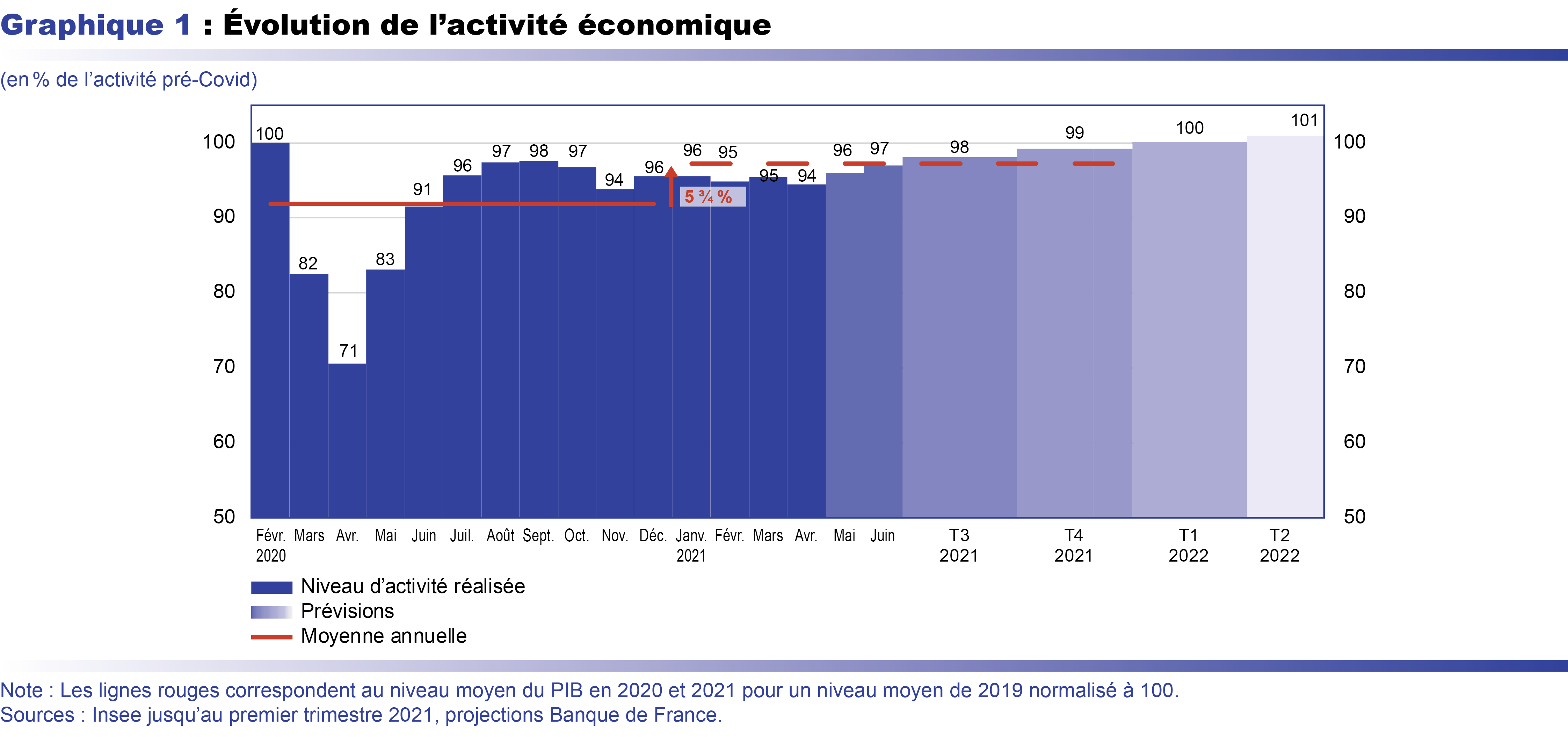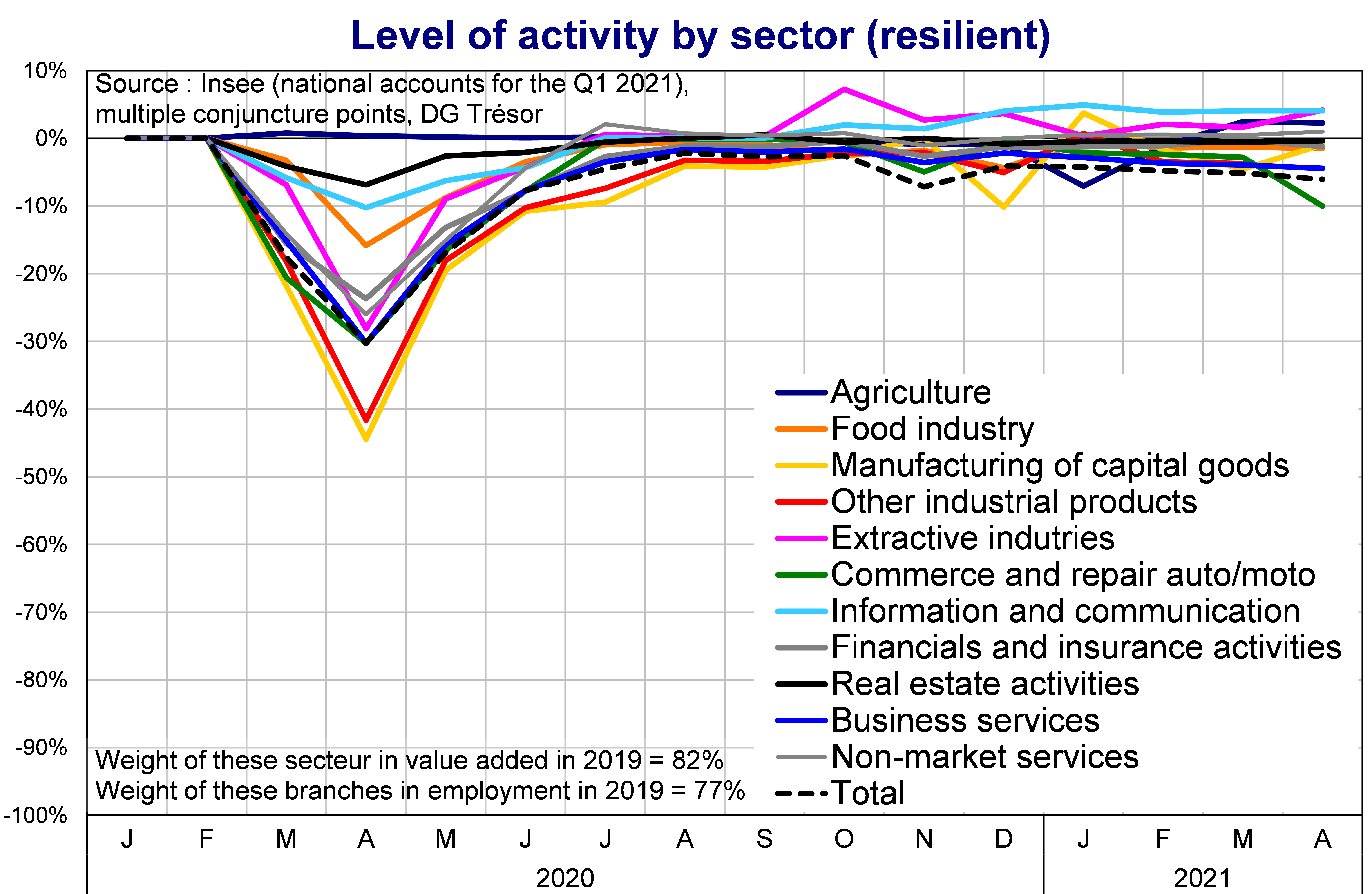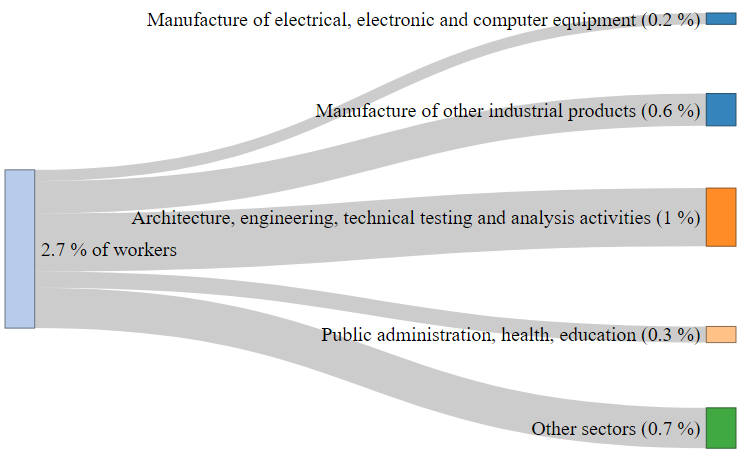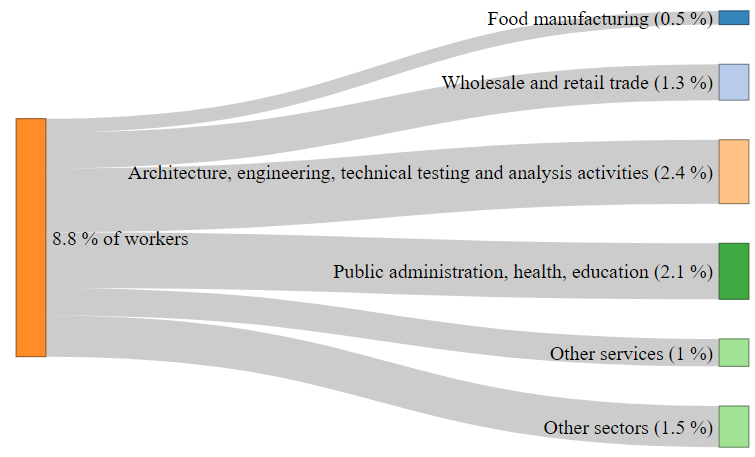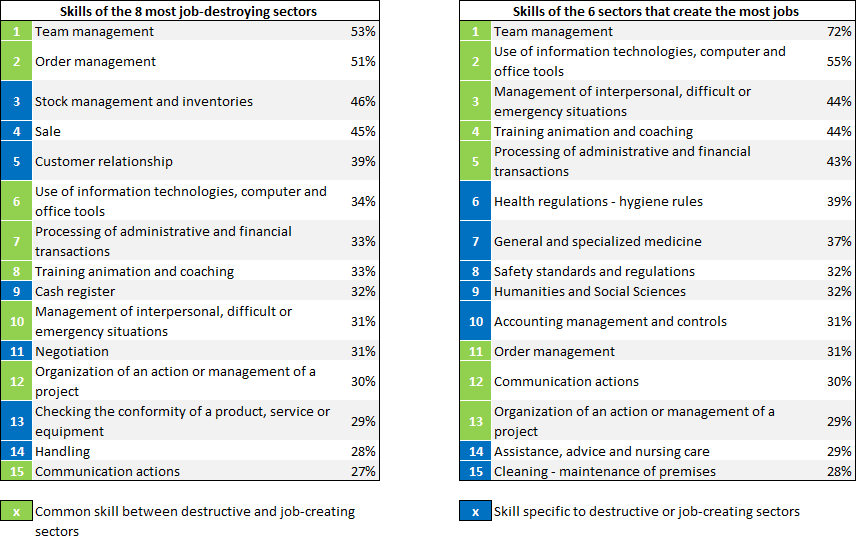Labor Reallocations: Time for Practice
According to the latest forecast from the Banque de France, the level of activity in France, in June is only 3% below its pre-crisis level, and this gap will be closed by the first quarter of 2022 (Chart 1). Does this mean the crisis is behind us? Not quite yet.
Looking for the omniscient worker
As we all know, GDP is the sum of firms’ value added. Some of them have already returned to their pre-crisis level of activity (some have even exceeded it), while others are lagging behind. Within sectors, the recovery is not uniform because demand has shifted. If workers were omniscient, versatile and perfectly mobile, they would instantly relocate to wherever there is a demand for labor. There would be no unemployment and no constraint on GDP if demand is there.
But of course the real world is a different story. A stewart, for instance, cannot turn himself overnight into a heat pumps installer in private homes or a care provider for the elderly. Not only does he usually lack the right skills, but he often ignores that such job opportunities exist. The "representative worker" producing units of GDP per capita does not exist. If demand picks up slowly in air transport and more strongly in thermal renovation, the former industry will be demand-constrained in the short run while the latter will be supply-constrained. As Restrepo (2015) has shown, difficulty in identifying the right workers out of many applicants may even lead firms in dynamic sectors to restrict hirings, which in turn reduces workers' incentives to train. In a nutshell, skills mismatch affects negatively the economy in a proportion that exceeds the size of the relevant labor force segment.
Source: Banque de France, Macroeconomic Projections, June 2021.
The idea of an uneven recovery is not theoretical. Compare the activity trajectories of sectors heavily affected by the crisis (Figure 2, top) to those which have been relatively unaffected (Figure 2, bottom). By April 2021, the sectors in the right-hand chart had returned to a level of activity close to (or even higher than) the pre-crisis level, while those on the left were still far from it. With the rebound from the reopening of the economy, the vast majority of workers in the sectors on the left-hand chart will return to employment. However, long-distance and business travel recovery will be gradual and perhaps incomplete, weakening the demand for air travel (and therefore airplanes), but also for taxis, international hotels, conference centres, luxury shops, etc. A major challenge in the coming period will be the ability of our economy to reallocate some of the workforce from these weakened sectors to expanding sectors, such as thermal renovation, care or digital-related activities.
Figure 2: Loss of activity compared to 2019 Q4, in %
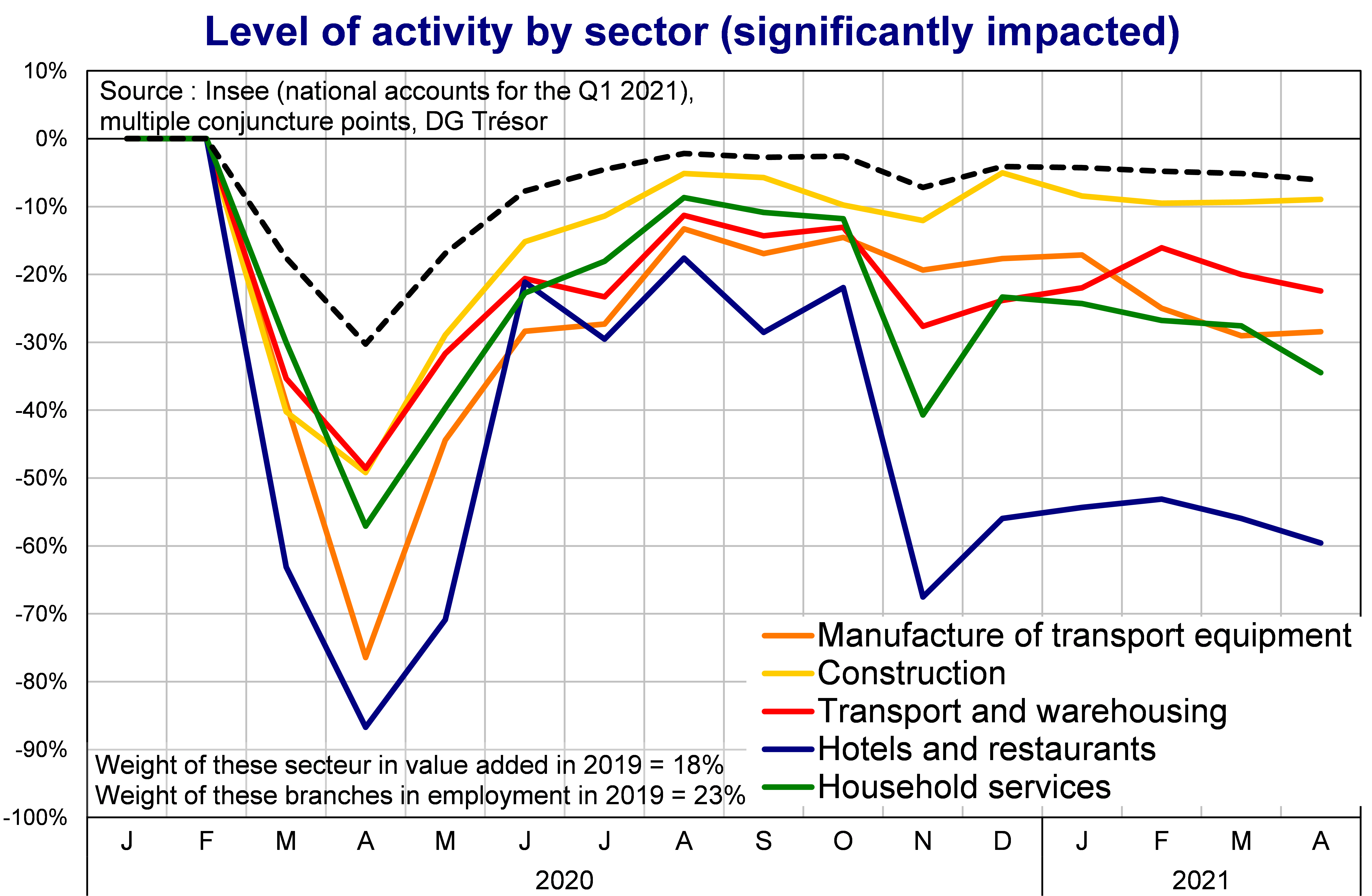
Source: French Treasury.
Skills to be transferred
While the vast majority of job changes occurs within the same sector (see Davis and Haltiwanger, 1992), cross sector mobility is still a significant phenomenon, especially in accommodation and food services, where 9 percent of the workforce switches to other sectors on average over a 6-quarter rolling window (average over 2008-2018, see Figure 3). The fact that employees in this sector are often young, at the beginning of their professional career and hired on short term contracts may explain this relatively high mobility. In the manufacture of transport equipment, on the other hand, a sector that includes the automotive and aircraft industries, workers are much less mobile: 2.7% move to another sector during a similar 6- quarter window.
Figure 3 - Sectoral mobility in two sectors (over six consecutive quarters, average 2008-2018)
Manufacture of transport equipment
Accommodation and food services
Source: INSEE (continuous Employment survey, 2008-2018 editions), calculations: French Treasury.
Note: On average over the period 2008-2018, 2.7 percent of people working in transport equipment manufacturing had moved to another sector 6 quarters later. Among them, 1 percent moved to scientific and technical activities.
Each worker has a unique combination of skills, experiences, motivations and personal constraints. Some skills, such as proficiency in English, accounting, or digital technologies, are easily transferable across sectors; it is not so much the case for other skills such as sales or inventory management. Table 1, from Trésor-éco No. 287, compares skills most commonly used in job-destroying sectors in 2020 (on the left) to those commonly used used in the job-creating sectors over the same period (on the right). We can see, for example, that the ability to manage a team is required in 53% of jobs in "laying off " sectors and 72% of jobs in hiring sectors. Therefore statistically, more than half of the workers occupying at-risk jobs have a skill that is in high demand in growth sectors. In contrast, inventory management is a skill that is common in "laying off" sectors but not so much in hiring sectors.
Table 1. Skills most used in job-destroying sectors* and in job-creating sectors** in 2020
* Eight sectors that were the most job destructive in 2020: accommodation and food services, arts, entertainment and recreation, trade, administrative services, other services, transport equipment manufacturing, metallurgy, financial and insurance activities.
** Six sectors that were the most job-creating in 2020: IT activities, scientific research and development, medical and social accommodation, education, construction, human health activities.
Sources: Pôle Emploi ("node" skills), Insee (continuous Employment survey, 2019 edition).
Note: 53% of employment in the eight most job-destroying sectors uses the skill "team management". This skill is also found in the six most job-creating sectors, where 72% of employment requires this skill. The skills in green are those that are common to both job-destroying and job-creating sectors.
Using Italian data from 2015 to 2018, Basso, Grompone and Modena (2021) confirms that job proximity in terms of skills has a highly significant impact on the probability of job-to-job transition. To maximize the chances of workers in at-risk jobs to move to an expanding sector, a quick fix would consist in having them trained for the skills listed in blue in the table on the right. Unfortunately, this is where things get complicated.
First of all, the skills described in the table are quite broad, for example, knowledge of standards and safety varies greatly depending on the sector concerned. Therefore, the needs may actually differ from the specific skills of available workers.
Second, some skills are difficult to acquire, such as "generalist and specialist medicine" or, to a lesser extent, nursing and accounting. More generally, skilled workers are more likely to have the specific skills required in job creating sectors: on the left of the table 1, skills marked in green are often those of skilled workers, while those marked in blue are more often those of low-skilled workers. Unfortunately, job training opportunities are less often directed at low skilled workers, particularly in high-risk sectors such as retail.
Finally, it can be tricky to get workers in vulnerable sectors to train for new projects: aside from family constraints and the costs associated with possible geographic mobility, they also need to identify the interest in retraining, to be informed about the range of possibilities and how to access them.
Hence we cannot emphasize too much the importance of professional training in the coming period, particularly for low-skilled workers. There are already many schemes both for those in employment and the unemployed. The Recovery Plan has strengthened them to provide better support for employees benefiting from the furlough scheme or whose jobs are threatened as well as for young people and jobseekers to guide them towards promising occupations. The reform of professional training, in particular through the personal training account, allows for an easier access to training. It is essential to continue along this path, which implies above all effective information for the people who need retraining. In this area, innovative ideas and ever more dedicated action will be needed to ensure that schemes reach their target, keeping in mind the need for careful evaluations so as to continuously improve the schemes. This is just the beginning of a broader jobs reallocation that will be spurred by the ecological and digital transitions.
***
Read more :
>> Version française : Réallocations de main d’œuvre : place aux travaux pratiques
>> All posts by Agnès Bénassy-Quéré, chief economist - French Treasury
